Comments / Questions (11)
![]() Dorothea wrote:
Dorothea wrote:
Hallo, normaalgesproken is een voorpand bovenaan lager dan het achterpand. Hier wordt op dezelfde hoogte na de kraag verder gebreid. Is dat goed en past de trui dan wel goed?
08.06.2025 - 19:33DROPS Design answered:
Dag Dorothea,
Klopt, er is geen verschil tussen voorpand en achterpand qua hoogte bij de hals. Dit is wel vaker zo en de trui past goed.
09.06.2025 - 09:16
![]() Debbie G wrote:
Debbie G wrote:
Thank you for your last detailed explanation. That helped a lot. I would've never figured it out without your help!
19.03.2025 - 00:08
![]() Debbie G wrote:
Debbie G wrote:
Hi, I'm confused. I went to my local shop and they are a confused as well. We don't understand your increase totals. Can I ask the question another way? If so --Am I correct in assuming rows 1-4 will basically repeat? Maybe can you provide more detail row, by row for 4 rows, with total stitch count at the end of each row? I don't want to frog this project because I love the sweater design! I also have left my email address if you'd rather email me.
16.03.2025 - 23:25DROPS Design answered:
Dear Debbie, first round: increase 8 stitches (2 stitches for each sleeve, 2 stitches for the front piece, 2 stitches for the back piece). 2nd round: No increases. 3rd round: like 1st round. 4th round: like 2nd round. Work like this until you have worked a total of 2 to 7 (depending on the size) increase rounds. Now, you increase for the back/front as before but for the sleeve once every 4th round: First round: increase 8 stitches as before. 2nd round: no increases. 3rd round: increase 2 stitches for front piece, 2 stitches for the back piece (= 4 stitches increased). 4th round: No increases. Repeat these 4 rounds 9 times in total. Happy knitting!
16.03.2025 - 23:57
![]() DEBBIE G wrote:
DEBBIE G wrote:
Follow on to Rania's question. When I calculate the # stitches for the increases from 88 stitches (size SM), I end up with too many st. I'm figuring: R1: Incr F&B raglan (Total 92 st). R2: Incr 0. R3: Incr F&B raglan (96 st.). R4: Incr Sleeve raglan + F&B (104 st) and so on. 18x for F&B and 9 for Sleeves would take me 36 rows with a total of 232 st. This is way off from the pattern. Help!
13.03.2025 - 17:44DROPS Design answered:
Dear Debbie, at the beg you get 17 sts for front & back piece and increase then for raglan a total of 2 sts 2 times then 2 sts 18 times= 57 sts ; for sleeves there are 13 sts + 2 sts 2 times + 2 sts 4 times = 35 sts, so that you have 57 x 2 (front and back pieces) + 35 x2 (sleeves) + 3 sts x 4 (raglan sts) = 196 sts in total. Note that you will increase 18 times 2 times on back /front pieces but at the same time only 9 times on sleeves: R1 increase 8 sts: as before back/front and sleeves, R3: increase sts: back/front only.Happy knitting!
14.03.2025 - 07:25
![]() DEBBIE G wrote:
DEBBIE G wrote:
Sorry, I hit SEND too fast. To add on to my question. That would mean at the end of the round, since it's 2 stitches of the raglan, I should P1 K1 the last 2 stitches, correct?
12.03.2025 - 01:51DROPS Design answered:
Dear Debbie, see previous answer, the 3 raglan stitches should be all knitted, but should match the (K1, P1, K1) worked on neck before. Happy knitting!
13.03.2025 - 14:12
![]() DEBBIE G wrote:
DEBBIE G wrote:
I think my question was answered. To be sure: I need to increase AFTER the first stitch in the round and then BEFORE the last 2 stitches at the end of the round. Furthermore, am i to understand that for the 3 raglan stitches I should be doing a K1 P1 K1? If that's the case, it would be easier if the pattern was written that way rather than as a notation.
12.03.2025 - 01:47DROPS Design answered:
Dear Debbie, that's right you will increase for sleeve after the first stitch of the round and increase at the end of back piece before the last 2 stitches. The 3 raglan stitches are knitted but they should match (K1, P1, K1) from rib on neck before. Happy knitting!
13.03.2025 - 14:09
![]() Debbie G wrote:
Debbie G wrote:
I'm on the Yoke and did the first row of increases. Next the pattern says to increase on both sides of the 3 raglan stitches. In my calculation that would = 6 stitches increased. But the pattern says 8 st increased and I can't figure out where the other 2 stitches come from. Please advise
12.03.2025 - 01:04
![]() Judith wrote:
Judith wrote:
In der Beschreibung zur Passe ist angegeben dass ich an 3 Stellen 3 Raglanmaschen zu stricken habe. Ist dann denn richtig? Muss nicht ein Pullover 4 Raglanlinien haben, so dass man an 4 Stellen je 3 Raglanmaschen stricken müsste. Ich bin leider noch Anfänger und halte mich daher an die Anleitung. Würde mich über eine Antwort freuen
26.11.2024 - 14:52DROPS Design answered:
Liebe Judith, am Anfang der Runde stricken Sie die 1. Masche von diesen 3 Raglan-Maschen und am Ende der Reihe stricken Sie die 2 letzten von den 3 Raglanmaschen, so beginnen die Runden ca in der Mitte von den Raglanmaschen so sind es insgesamt 4 Mal 3 Raglanmaschen. Viel Spaß beim Stricken!
26.11.2024 - 16:44
![]() Antonella Serio wrote:
Antonella Serio wrote:
Sorry, war ein Denkfehler von mir. Die Anleitung ist richtig ! FG
03.11.2024 - 00:19
![]() Serio Antonella wrote:
Serio Antonella wrote:
Hallo, wenn nach den ersten 28 Maschen 1 Markierer angebracht wird, ist der Rundenbeginn bei mir an der linken hinteren Schulter und nicht wie in der Anleitung vermerkt an der rechten hinteren Schulter. Liegt bei mir ein Denkfehler vor oder muss die Anleitung korrigiert werden? Vielen lieben Dank für eine hoffentlich schnelle Antwort. Herzlichst, Antonella Serio
02.11.2024 - 18:49
Nimbus Haze#nimbushazesweater |
|
 |
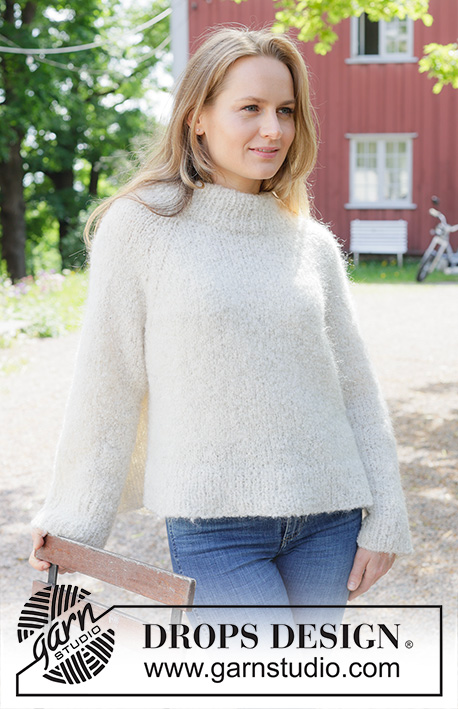 |
Knitted jumper in DROPS Alpaca Bouclé and DROPS Kid-Silk. Piece is knitted top down with raglan and vents in the sides. Size: S - XXXL
DROPS 252-33 |
|
|
---------------------------------------------------------- EXPLANATION FOR THE PATTERN: ---------------------------------------------------------- GARTER STITCH (when working back and forth): Knit on all rows, i.e. knit from right side and knit from wrong side. 1 ridge vertically = knit 2 rows. RAGLAN: Increase 1 stitch by making 1 yarn over, on next round knit yarn over twisted to avoid holes. Then work the new stitches in stocking stitch. DECREASE TIP (applies to mid under sleeves): Decrease 1 stitch on each side of marker thread as follows: Work until 3 stitches remain before marker thread, knit 2 together, knit 2 (marker thread is between these 2 stitches), slip 1 stitch knitwise, knit 1, pass slipped stitch over stitch worked. ---------------------------------------------------------- START THE PIECE HERE: ---------------------------------------------------------- JUMPER - SHORT OVERVIEW OF THE PIECE: In this pattern needles of different length have been used, begin with fitting length for number of stitches and switch as needed. Work neck edge and yoke in the round on circular needle from right shoulder back, and work top down. When yoke is done, divide piece for body and sleeves. Work body down wards in the round on circular needle while putting the sleeves aside. Then work sleeves downwards in the round on needle. Fold the neck edge double against the wrong side and fasten. NECK EDGE: Cast on 72-76-80-80-88-92 stitches on circular needle size 7 mm with DROPS Alpaca Bouclé and DROPS Kid-Silk (= 2 strands). Switch to circular needle size 5 mm (cast on on a larger needle to get an elastic cast-on edge). Work rib in the round = knit 1/purl 1) for 14 cm. The neck edge is later folded in towards wrong side and assembled to form a neck edge of approx. 7 cm. Beginning of round is at right shoulder at the back. Insert 1 marker after the first 26-27-28-28-30-31 stitches on round (= approx. mid front), measures piece from this marker. YOKE: Switch to circular needle size 7 mm and work like this, work all stitches in stocking stitch: Work 1 stitch, increase 1 stitch for RAGLAN – read explanation above, work 13 stitches (= sleeve), increase 1 stitch for raglan, work 3 stitches (= raglan stitches), increase 1 stitch for raglan, work 17-19-21-21-25-27 stitches (= front piece), increase 1 stitch for raglan, work 3 stitches (= raglan stitches), increase 1 stitch for raglan, work 13 stitches (= sleeve), increase 1 stitch for raglan, work 3 stitches (= raglan stitches), increase 1 stitch for raglan, work 17-19-21-21-25-27 stitches (= back piece), increase 1 stitch for raglan, work 2 stitches. NOTE! Work the 3 stitches in each raglan line over knit 1, purl 1, knit 1 from rib. Work in stocking stitch in the round while AT THE SAME TIME increasing for raglan on each side of the 3 raglan stitches every other round 2-3-6-6-7-7 times in total = 88-100-128-128-144-148 stitches (= 8 stitches increased on every increase round). Remember to follow the knitting tension! Then continue increase as follows: Increase for raglan on every other round on front piece and back piece, but on sleeves increase only on every 4th round (= alternately 4 and 8 stitches increased), repeat this increase 18-18-16-18-18-18 in total times on front piece and back piece and 9-9-8-9-9-9 times on sleeves. After last increase there are 196-208-224-236-252-256 stitches on needle. Work until piece measures approx. 25-26-28-30-31-32 cm from marker mid front. Now divide yoke for body and sleeves. DIVIDING FOR BODY AND SLEEVES: AT THE SAME TIME as next round is worked divide yoke for body and sleeves as follows: Slip the first 37-39-43-45-47-47 stitches on a thread for sleeve, cast on 6-6-8-10-12-16 new stitches on needle (= in the side mid under sleeve), work 61-65-69-73-79-81 stitches in stocking stitch (= front piece), slip the next 37-39-43-45-47-47 stitches on a thread for sleeve, cast on 6-6-8-10-12-16 new stitches on needle (= in the side mid under sleeve), and work in stocking stitch over the last 61-65-69-73-79-81 stitches (= back piece). Finish body and sleeves separately. BODY: = 134-142-154-166-182-194 stitches. Insert 1 marker thread in each side on body, in the middle of the 6-6-8-10-12-16 stitches cast on under each sleeve and move the marker threads when working, use the marker threads when piece is divided for vents in each side. Work in the round with stocking stitch until piece measures 39-41-43-44-46-48 cm from marker mid front. Now divide the piece for a vent in each side of body, divide at the marker threads by setting the stitches from back piece on hold and working stitch from front piece back and forth on needle as explained below. FRONT PIECE: = 67-71-77-83-91-97 stitches. On next row (= right side) begin rib while AT THE SAME TIME increasing 16-18-18-20-22-24 stitches evenly on needle = 83-89-95-103-113-121 stitches, work as follows: Continue with circular needle size 5 mm, work 2 stitches in GARTER STITCH - read explanation above, work rib (= knit 1/purl 1 - remember increase) until 3 stitches remain, knit 1 and 2 stitches in garter stitch. When rib measures 8-8-8-9-9-9 cm cast off. Jumper measures 47-49-51-53-55-57 cm from marker mid front and approx. 52-54-56-58-60-62 cm from the top of shoulder. BACK PIECE: Work as on front piece. SLEEVES: Slip 37-39-43-45-47-47 sleeve stitches from one thread on to circular needle size 7 mm and pick in addition up 1 stitch in each of the 6-6-8-10-12-16 stitches cast on under sleeve = 43-45-51-55-59-63 stitches. Insert 1 marker thread in the middle of the 6-6-8-10-12-16 new stitches under sleeve - round begins at the marker thread. Work in stocking stitch in the round on needle - AT THE SAME TIME when sleeve measures 3 cm from division, decrease mid under sleeve – read DECREASE TIP and decrease as follows: Decrease 2 stitches every 14-9-5½-4½-3-2½ cm 3-4-6-7-9-10 times in total = 37-37-39-41-41-43 stitches. Work until sleeve measures 36-35-33-32-31-30 cm from division. Switch to double pointed needles size 5 mm and work rib (= knit 1/purl 1) while AT THE SAME TIME increasing 7-7-7-9-9-9 stitches evenly on 1st round = 44-44-46-50-50-52 stitches. When piece measures 6 cm cast off. Sleeve measures approx. 42-41-39-38-37-36 cm from division. ASSEMBLY: Fold rib at the top of neck down on inside of garment. Fasten rib to get a double neck edge. To avoid a tight neck edge that sticks out it is important to keep the seam elastic. |
|
 |
|
Have you finished this pattern?Tag your pictures with #dropspattern #nimbushazesweater or submit them to the #dropsfan gallery. Do you need help with this pattern?You'll find 31 tutorial videos, a Comments/Questions area and more by visiting the pattern on garnstudio.com. © 1982-2025 DROPS Design A/S. We reserve all rights. This document, including all its sub-sections, has copyrights. Read more about what you can do with our patterns at the bottom of each pattern on our site. |
|







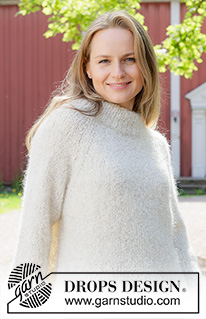
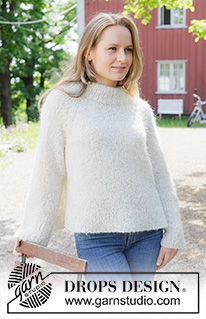
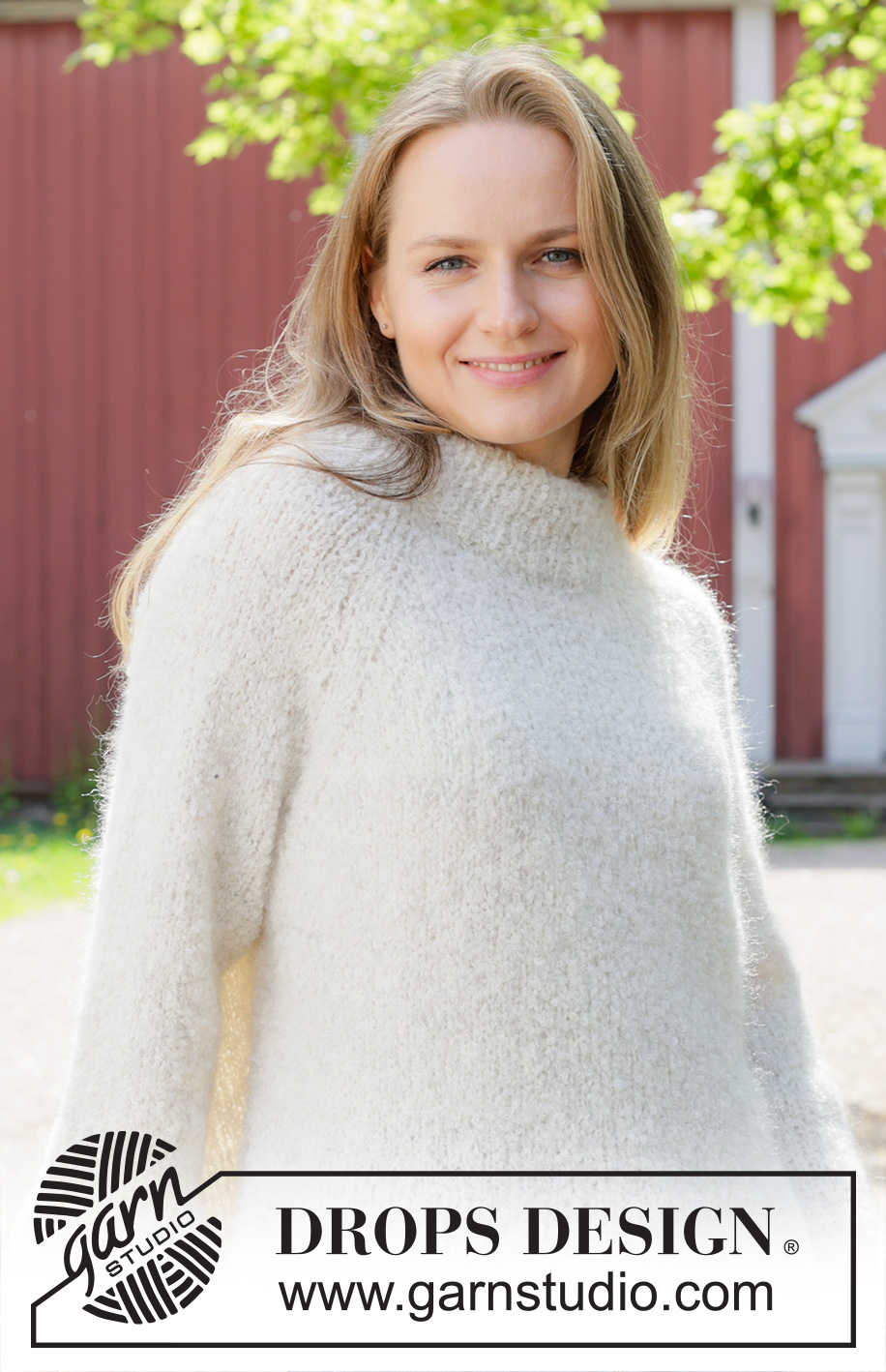
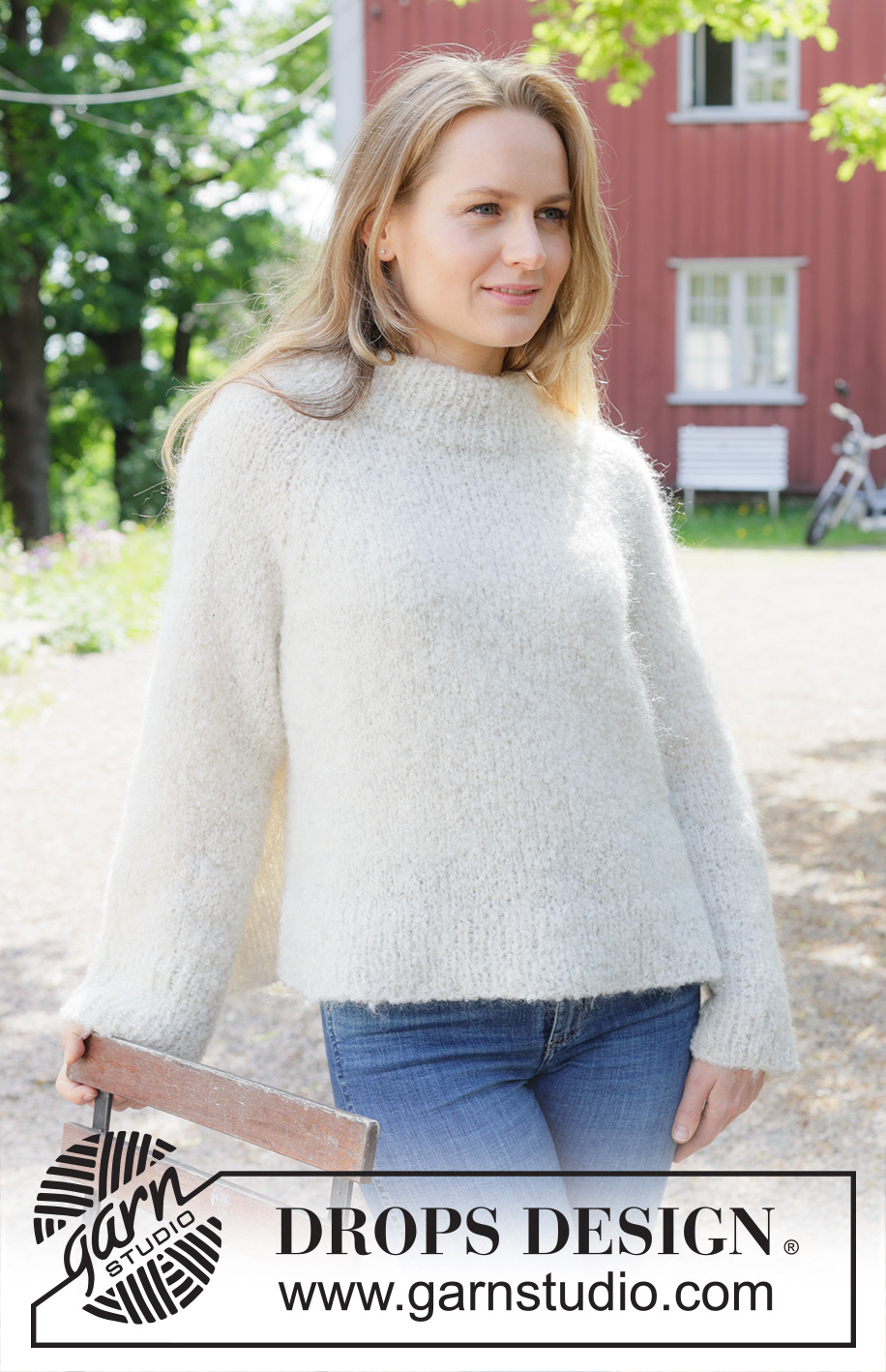


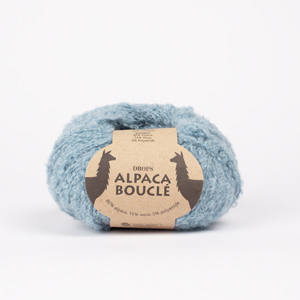
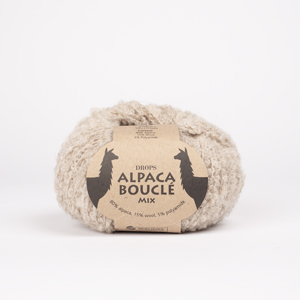
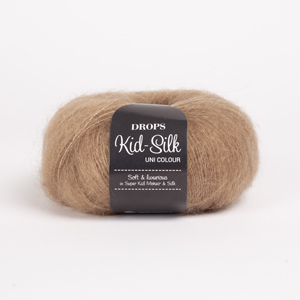

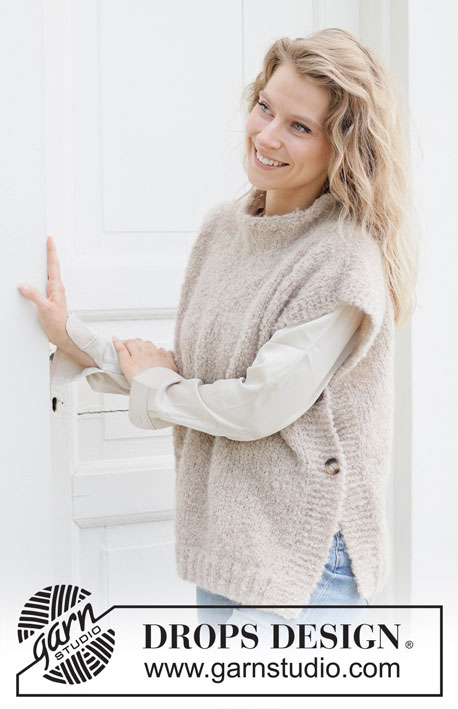




















































Post a comment to pattern DROPS 252-33
We would love to hear what you have to say about this pattern!
If you want to leave a question, please make sure you select the correct category in the form below, to speed up the answering process. Required fields are marked *.